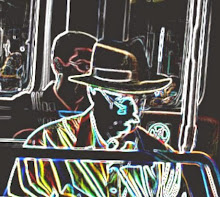It's never too late to recall a great performance ...
Are you one of those people who saves their theater programs, and maybe tickets, as memorabilia? Me neither. But I did save a postcard advertising a performance by Phillip Glass that was given at the Lincoln Theater in Miami Beach perhaps ten years ago. It popped up among some papers recently, and it seemed I could instantly hear the reverberations of that night echoing through time.
 I'm fortunate enough to have seen three performances of Glass's music, including the one I wrote about (here and here) at the University of Miami in 2008. The first time was back in the 1990's at Gusman Hall in downtown Miami, when Glass performed solo piano pieces and a duet with a soprano sax.
I'm fortunate enough to have seen three performances of Glass's music, including the one I wrote about (here and here) at the University of Miami in 2008. The first time was back in the 1990's at Gusman Hall in downtown Miami, when Glass performed solo piano pieces and a duet with a soprano sax.The piano playing that night was interesting in its use of expressive devices normally considered the realm of more traditional, even romantic, music. Variations in volume and phrasing, rubato (subtly modulating the tempo), and song-like lyricism -- all gave the lie to the perception of Glass's music as mechanistic or automated. The duet was notable for the use of a row of ten or twelve music stands that held the unfolded score for the saxophonist. Throughout the performance he gradually moved his way from left to right across the stage rather than turning pages. It was a practical solution that also served to let us know how far through the piece we were, rather like the progress bar at the bottom of an Internet video (which didn't exist yet at the time).
Glass has been known for some interesting collaborations, such as the ones in Songs From Liquid Days which includes Paul Simon, Linda Ronstadt, and the Roche sisters. But an especially fruitful partnership is the one that brings us back to that Miami Beach concert. The music for The Screens, a play by Jean Genet, introduced the rest of the world to Foday Musa Suso, Gambian master of the kora. (Jazz fans may have noticed his collaborations with Herbie Hancock on the albums Village Life and Jazz Africa.)
 The kora bears a resemblance to the Indian sitar. Both use large gourds as a soundbox and have long necks with multiple strings. But they are held and played in entirely different ways. The sitar player cradles the gourd with the sole of one foot, strums the strings with a plectrum worn on the finger of one hand, and selects and bends the notes by pressing the main melodic string against a metal fret, somewhat like a guitar. The kora player, on the other hand, holds his instrument upright before him, grasps it by a pair of handles, and plucks its 21 fixed-pitch strings with the thumbs and index fingers of both hands. It's really more like a European zither, and its native music is like what we know from the kalimba, or thumb-piano, which is also from Africa.
The kora bears a resemblance to the Indian sitar. Both use large gourds as a soundbox and have long necks with multiple strings. But they are held and played in entirely different ways. The sitar player cradles the gourd with the sole of one foot, strums the strings with a plectrum worn on the finger of one hand, and selects and bends the notes by pressing the main melodic string against a metal fret, somewhat like a guitar. The kora player, on the other hand, holds his instrument upright before him, grasps it by a pair of handles, and plucks its 21 fixed-pitch strings with the thumbs and index fingers of both hands. It's really more like a European zither, and its native music is like what we know from the kalimba, or thumb-piano, which is also from Africa.Blending and extending this instrument through the addition of other Western instruments, including piano, flute, synthesizers, bass, and reeds, is the task that Glass undertook in order to build a unique sound for The Screens that would resonate with its Algerian setting. No doubt it helped that the kora's forte is exactly the sort of hypnotically repetitious, rhythmically based "loops" that Glass himself is known for. Suffice to say that the experiment was a resounding success -- so much so that they occasionally got together in performance to reproduce it long after the recording was widely known.
Glass informed us that night that we shouldn't expect an exact reproduction of what we might know from the album. Incorporating large elements of improvisation, the performances varied widely. So much so that he said they had more or less decided between them that whenever they got together to play, whatever came out would be The Screens.
So there it is, a flow of music still flowing after all these years like a river in its bed, drawing its wavering line in the sands of my memory. Here's a sample. Enjoy. (And look for the website fmsuso.com on the gourd.)









No comments:
Post a Comment